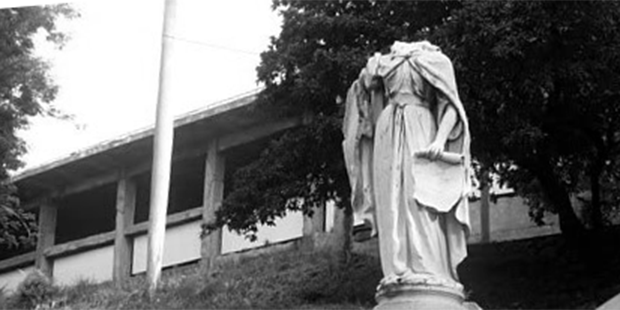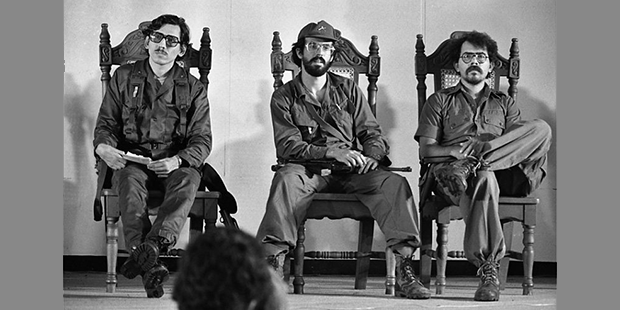In the photograph above, writes historian Elena Salamanca, Daniel Ortega and his fellow Nicaraguan revolutionaries are slyly ridiculing the aristocratic elites they had just overthrown. But as Ortega shuffles toward yet another reelection, the throne increasingly fits him.
“Don’t let sweet dreams lull you to sleep, Daniel Ortega,” I once wrote underneath a photograph of a powerful 1979 scene featuring the Sandinista commander. In the photograph, Ortega is seated in a carved wooden chair-lordly, one of those chairs that emulate the thrones of the pope or of Ferdinand and Isabella-very popular in Central American homes. The photo is powerful because it demonstrates the rupture with the overthrown Somoza regime; it is making fun, in a way, of the sacred symbols of Central American elites. In the context of 1979, the scene seems to represent a rupture with the past. But in fact the photo represents continuity, a continuity that extends right down into the present.
Daniel Ortega is running, for the SEVENTH TIME, as the Sandinista National Liberation Front [FSLN] candidate for Nicaragua’s presidency. He is already completing his third term as president of Nicaragua; his first elected [post-revolution] term was in 1984, and he returned to the presidency in 2006. Since then, he has not released his grip on the office. It appears that he will soon begin his fourth term, given that last month the parliamentary opposition was legally invalidated, thereby neutralizing for Ortega’s benefit the legislative branch. What Ortega has done is nothing new, but it is worth pointing out that this practice was the normal way things were done in Central American political culture in the 1930s and 40s-when it was described as tyrannical.
And that is why I am interested in how Ortega uses ‘History’ in his speeches. They illustrate something we already know in the back of our minds: that the Left manhandles History for its own convenience. The Leftist narrative, at least in Central America, is built on historical genealogies which allow the Left to settle into power much like those medieval kings who seated themselves on thrones of gold and velvet.
Between 1930 and 1940, Jorge Ubico in Guatemala, Maximiliano Hernández Martínez in El Salvador; Tiburcio Carías Andino in Honduras; and Anastasio Somoza García in Nicaragua all held onto power via practices which were very similar to those used by Ortega nowadays. By way of constitutional reforms or the creation of new constituencies, the military presidents, these little generals, found ways to get themselves elected president: Again! This time democratically! And that is why I have to ask what exactly differentiates now the practices of Ortega and [longtime former dictator]Anastasio Somoza Sr.[whose family dynasty was overthrown by Ortega’s Sandinistas in 1979]How many times had the various central American military presidents gotten themselves reelected when the revolutionary wave of 1944 began? Four times. Ortega, now completing his third term, is following their example, looking toward history in order to repeat it, though without any of the wisdom one might hope to have gained from it. Rather, he seems to me to heading toward repeating all of their errors and cruelties.
The organic intellectuals of the left love [Italian political theorist] Antonio Gramsci. I do too. The Prison Notebooks are to me as luminous as the Bible is to Catholics and Evangelicals. From their pages shines the light that lets me see with fresh eyes these Central American lefts, born in guerilla struggles and transformed into governing parties. Gramsci wrote with great clarity on the relationship between post-war and hegemony. His own studies were focused on the First World War and a number of internal conflicts, but it seems to me that his work is nevertheless useful to interpret what is happening in Nicaragua:
The ‘normal’ exercise of hegemony on the now classic terrain of the parliamentary regime is characterized by a combination of force and consent which balance each other, so that force does not overwhelm consent but rather appears to be backed by the consent of the majority, expressed by the so-called organs of public opinion (which in certain situations, therefore, are artificially multiplied). Between consent and force stands corruption/fraud. This consists in procuring the demoralization and paralysis of the antagonist (or antagonists) by buying its leaders—either covertly, or, in cases of imminent danger, openly—in order to sow disarray and confusion in his ranks. [Prison Notebooks, Vol. 1]
What Gramsci points out here is what is happening to the left itself; it no longer even knows if it is socialist. When those who struggle against power, against hegemony, are transformed into power’s most important architects, the path that is left to us always seems to lead toward corruption. There remains no possibility, at least emanating from Ortega’s FSLN, of a counter-hegemony. Because that is what the FLSN has become, precisely: a party of Ortega; a “personalist” party; something Gramsci reflected on as well: “personalist parties are based on the protection bestowed on those below him by a powerful man.”
More than anything else the Sandinistas of today resemble a sect in which dissenters are not tolerated, but are purged. We are watching the serpent eat its tail, with gusto. Among the various socialisms, I believe that it is Gramsci’s which preserves the values of justice, equality and liberty which many of us long for. It is by way of Gramsci’s ideas and not those of the copycats of the Sandinistas or El Salvador’s FMLN that some of us are able to think in a socialist key. It seems to me that (in its spectrum from the Utopian to the Gramsician) socialism is at once the most lucid and beautiful way of thinking about the western world of the last few centuries, and also the most terrible, the most manhandled, and the most fatally cracked in practice. Ortega is a never-ending slap in the face: he makes belief in the left feel ever more like believing in the Virgin of Guadalupe: an easily dismantled belief that does little but hurt the heart and destroy hope.
The first time I traveled to Nicaragua was more than ten years ago. I was young and enthralled by [early Nicaraguan revolutionary]Augusto Sandino’s struggle. I went to Tiscapa to commemorate the revolution, and I stood in front of that enormous sculpture of Sandino which watches over Managua from the hill. I had not actually read Sandino’s letters or philosophy [Sandino was murdered in the 1930s, decades before the revolution which bore his name]. The Sandino that I knew was the one who had been constructed by the FSLN to give a historical grounding to the 1979 revolution. Like the sculpture of Sandino itself: a Sandino constructed to the measurements of those who would do their song and dance from behind his image.
At Tiscapa I also saw the Monument to the Republic, and it struck me more powerfully. It was a figure in white marble, in that Greco-Roman style that all the Romantics who built Latin America’s republics in the 19th century returned to over and over again, in an effort to give us an iconography for our national identities. There was something in it that seized me in a way the Sandino monument had not: The figure of the Republic was decapitated. Why, I asked the guide, had her head not been restored? “It represents the fall of the Somoza dictatorship,” I was told.
Since then, the Republic of Nicaragua has been headless.

Liberty, decapitated. Photo: Erick Vargas.
The symbolic construction of the narratives of Sandinismo and the FSLN are laudable in the sense that their discourses truly succeeded in creating a sense of common identity, in making History have a certain logic for many or almost all. The problem we confront now is this corrupt use of history, which as I said, is common in the construction of political traditions. This same manipulation is what has permitted Ortega to transform himself into a fourth Somoza, one who more closely resembles Anastasio Somoza Sr. than either of his sons; and at the same time permits him to keep getting the votes of those who gave up their whole lives and families for the Sandinistas.
But there is a proviso. If Daniel Ortega can rely on history to enthrone himself (‘the Sandinista Revolution is more alive than ever,’ he said recently), history can also dethrone him.
Elena Salamanca Translated from Spanish by International Boulevard.
26 Aug 2016




































